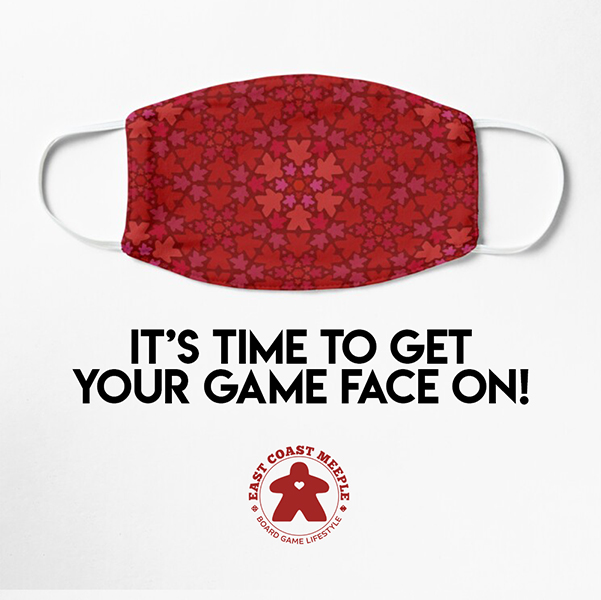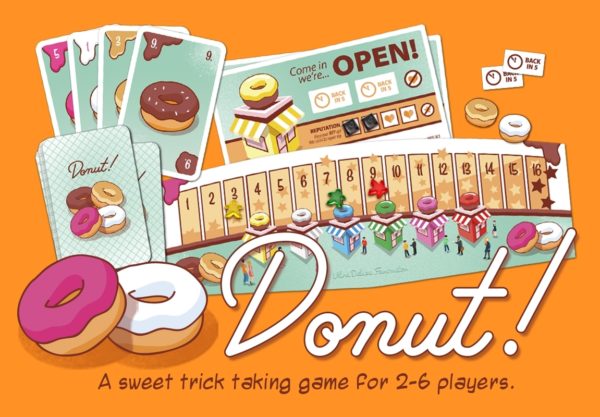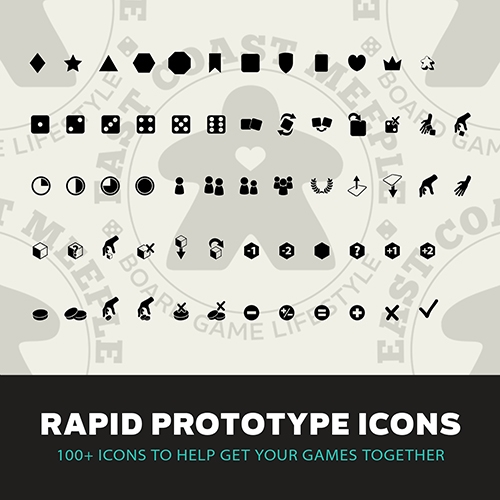
the Squire Merchant
An interview with artist & designer Jon Merchant
~Jon Merchant~
My art has always been my motivator, having done everything from fine art, book covers, logos, children’s books, and of course, tabletop game illustrations over the years.
Hi Jon. Thanks again for being an agreeable sort. Here are a bunch of questions.
Hi Mitch, no problem, always glad to answer a few questions and dive into my experience.
You have a few projects up on your Game Crafter page. How long have you been tinkering with game design? Have you always been reworking games/designing your own or is it something fairly new?
Ever since I was a kid. I’ve created games in RPG maker for computer, made my own themed versions of monopoly, my own tabletop RPG in high school, and countless other small designs that usually didn’t pan out. It has only been the last few years that I have taken it seriously, combining my love for design and art to create a fully finished product.



What were some of your favourite games growing up?
I grew up mostly playing Pokemon and Zelda like most kids my age, but soon graduated to other video games like Morrowind, Quest for Glory and Zelda. My first ‘real’ board game purchase was a little something called “Heroquest” (which I picked up for $1 at a garage sale). I loved it so much I started making my own characters and expansions.
Most people have a modern introduction story that moved them from the mass market world to the hobby game world. (For me it was really early on with a friend bringing the 1st edition of Talisman to my house. It was still just a roll and move game, but it had so much story and immersion that it kind of melted my young brain). Do you have a transition game that really opened your eyes to what was possible with games?
Oddly enough, even after HeroQuest and my many other ventures into game design as a kid, I never really got ‘into’ board games for many years. As a very casual gamer, I don’t know if there was a game that really acted as this transition for me. My entry into the hobby started a couple years ago as a close friend found a playing card manufacturer, and I had an artistic desire to just create something. So I got into designing my own small 18 card game, submitted it to a contest, and ever since have had my eyes opened to a whole other world of gaming.
What are some of your current favourites right now? What have you been playing the most lately?
At my core, I am a casual gamer, so the smaller, lightweight often 2-player games are what make up my current collection. I’ve been really enjoying Cartographers (you draw shapes to create a custom map, it’s definitely my thing). I also love Silver and Gold, another flip-and-write game about finding treasure. Tiny Towns is another new addition I’ve been playing a fair bit!
Microgames are a relatively new genre, Love Letter probably being the first real runaway success. You have designed a few micro games now. What’s the attraction for you to this style of game?
It started out as a way to dip my toes in the design space. But the more I designed large-scale games, the more I found it important to boil down a game to its core experience, often leading to smaller and more component-light games. I think I just like the challenge and results of creating something with certain limitations. While I still have a few larger games in the works, my heart is in the microgames, and I’ll likely stay here a while.


You had mentioned to me earlier that Letiman Games reached out and offered to publish “Squire for Hire” during the Kickstarter campaign, was this a complete surprise? Had you been in contact with Letiman before the campaign?
Quite quickly into the campaign, I realised it was going to get bigger than my self-publishing dreams intended. I had been following Letiman Games online for a while, as well as the awesome folks they had worked with in the past, so I already had an idea who they were. When Dan from Letiman and I first started talking during the campaign, I was a bit surprised by his interest in the game – Squire for Hire was my first Kickstarter for a hand-drawn microgame that I had fully intended on producing and fulfilling by myself. There was a bit of shock.
It must have taken quite a bit of pressure off to have them step in. Was it a smooth affair changing over or was there a bit of craziness to switch gears?
There wasn’t much of a transition, perhaps because the game was nearly ‘done’. That being said, Letiman made the publishing aspect a breeze, and definitely took a lot of pressure off to have that knowledge and experience helping through the entire process. I’m pretty ecstatic to continue working with Dan on the next expansion as well, it wouldn’t be what it is now without his help.
In the video you did with James on the Vorpal Board video (which does a great job highlighting your game and is a pretty fun look at what is coming with the Vorpal Board) he asks you about the development of “Squire for Hire” and you mention that it started out as a much bigger game and you slowly distilled it down to what we have now. Was it originally a system inside the larger game that sort of took your interest and you focussed in on it?
Yes exactly – I’ll explain a bit more. It started as a large roll-and-move inventory management game, where you adventure around a board, and collect items (which were polyomino tiles of various sizes that you had to fit in your “bag”). It became cluttered and unruly trying to sort out the quest/reward system and balance the type and size of the components with the gameplay.
I knew there was something enjoyable about the core idea, but realised it was the ‘managing inventory’ that really got my attention. From there, I tried to incorporate the same aspect of completing quests and gaining loot without the big game of tiles and playerboards. I drew up a handful of loot cards on a tile grid, and Squire for Hire was born.

Image: LetimanGames.com
One advantage of co-publishing a game is that I’m still doing the bulk of the development. The other advantage is that it absolutely doesn’t have to be just me. The collaboration that Dan and I have during development is great, and I owe quite a few of the expansion’s key ideas to that exploration and having someone to bounce ideas around with.
Besides being able to bump your “Squire for Hire” experience up to 4 players with some added variety, are there any changes coming with it? New item types, variations in the mechanic?Yes! Part of what I wanted from the expansion was to build something entirely new. This meant not reusing the same items or squires. This meant I could also take it in a slightly different direction. All cards, squires and items have been drawn from scratch to fit a new “mountain” theme. All of the squires are animals typically found in the Himalayan mountains. There is a red panda, a yak, a sheep, and a snow leopard.
I also implemented Runes, which are a new item with three varieties: The Void rune can negate junk items, but cannot be covered. The Morph rune can change into any item you wish. The Hide rune lets you play new loot cards underneath other cards in your bag.
So there’s definitely a few new creative things you can do during the game to manipulate cards and scoring, especially when combining it with the original base game.

Image: patreon.com/JonMerchant
As an artist and a designer are you able to keep the artist side calm as you work on new designs or do all your prototypes get a pretty rich art development as you go? Do you have the nicest looking prototypes at meetups?
As I type this, I am looking at a first-draft, full-colour illustrated prototype sitting on my desk and realised I’ve definitely been called out. I absolutely have a hard time reigning in that artist side. Being an artist comes with perks I don’t take for granted, but also means I tend to spend a bit too much time on things that could change quickly.
Maybe it’s being an artist, but I am much more inspired by seeing something physically, and usually have a pretty good idea what I want a game to look and feel like, and that directly informs my design process.
More often than not, having a more complete prototype makes me realise faster what elements belong, or don’t. So my development process is still fairly quick. Squire for Hire started as a simple character illustration, and within a couple weeks I had the fully illustrated version tested and ready for Kickstarter.
Do you have a favourite artist in the business right now? If you had to focus on the game design and allow someone else to do the art for your next game who would you love to work with?
That’s a great question. Being the artist and designer usually means I’m working alone, but I absolutely have tons of artists I look up to and admire, and would love to work with someday. Danny Devine, Katy Grierson, Kyle Ferrin, Nolan Nasser are all welcome to steal a game from me to illustrate any day.
From the artist side, what designer would you love to do art for?
I’d love to illustrate something for Danny Devine or Steve Aramini. (Maybe it’s the shared loved of micro wallet games?) I’ve also got a couple close friends I’ve met online or at conventions I’d love to do the art for their games someday. Some really interesting ideas out there that I would love to put my spin on.
Thanks so much to Jon for taking the time to answer our questions and letting us know a bit more about himself and his projects.
Jon has given us a small taste of what is coming from him as a designer and an artist with “Squire for Hire” and he is keen to bring us more. If you want to follow along with Jon’s game designs and his art you should start by signing up for the Kickstarter newsletter for the upcoming launch of “Mystic Runes”. Also, be sure to check out his portfolio site and give him a follow on Twitter and Instagram ( @jonmerchant21 )
You should also check out Dan Letzring and Letiman Games while you are at it. Letiman Games has a newsletter to keep you up to date and they can be found on Instagram and Twitter as well ( @LetimanGames ).



















0 Comments